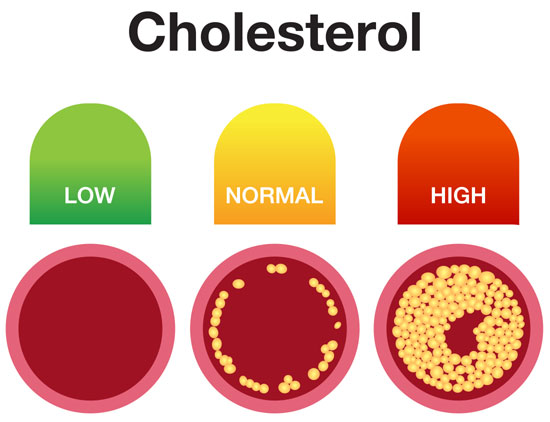Cholesterol and Your Health
How Low Should Your Cholesterol Go?
There are many misconceptions about cholesterol. What it does to our bodies, the medications we take for it, and what a healthy number is. I’m going to try and clear up some of that confusion.
What is cholesterol?
The American Heart Association says.
“Cholesterol is a waxy substance. It’s not inherently 'bad.' Your body needs it to build cells and make vitamins and other hormones. But too much cholesterol can pose a problem.
Cholesterol comes from two sources. Your liver makes all the cholesterol you need. The remainder of the cholesterol in your body comes from foods from animals. For example, meat, poultry and dairy products all contain dietary cholesterol.
Those same foods are high in saturated and trans fats. These fats cause your liver to make more cholesterol than it otherwise would. For some people, this added production means they go from a normal cholesterol level to one that’s unhealthy.”
Are there different types of cholesterol?
According to the CDC:
“LDL (low-density lipoprotein), sometimes called 'bad' cholesterol, makes up most of your body’s cholesterol. High levels of LDL cholesterol raise your risk for heart disease and stroke.
HDL (high-density lipoprotein), or 'good' cholesterol, absorbs cholesterol and carries it back to the liver. The liver then flushes it from the body. High levels of HDL cholesterol can lower your risk for heart disease and stroke.”

HDL is the HEALTHY or GOOD cholesterol. LDL is the LOUSY or BAD cholesterol.
What do the cholesterol numbers mean?
I’m just going to concentrate on the LDL or “bad” cholesterol. When your body has too much LDL cholesterol, it can build up on the walls of your blood vessels. That buildup is called plaque, and the condition is known as atherosclerosis. The more plaque you have, the narrower your blood vessels become. Over time plaque can block blood flow to and from your heart and other organs.

Blood vesseles with LOW, NORMAL and HIGH levels of plaque.
Children 19 and younger should have an LDL cholesterol number of less than 110 mg/dl.
Adults 20 and older have been told to get their LDL cholesterol number below 100 mg/dl. However, the National Institutes of Health now recommend an LDL below 70 mg/dl.
Why is controlling LDL cholesterol essential?
The leading cause of death for men and women in the United States is Heart Disease. According to the CDC, in 2017, it was responsible for 21.8% of all female deaths and 24.2% of all male deaths. The most common cause of heart disease is a narrowing or blockage of the coronary arteries, the vessels that pump blood to your heart.
Who’s at risk?
Researchers looked at the arteries of 2,876 people between the ages of 15 and 34 who died from accidents, homicides or suicides. They discovered fatty streaks in EVERY teenager they examined. Fibrous plaques were found in 65% of the 30-34 year olds.
Researchers now understand that “atherosclerosis begins in youth.” You shouldn’t wait to deal with a high LDL number once problems start because then, the treatments aren’t as effective.
Why don’t cholesterol-lowering drugs work better?
The problem is long-term damage. You can go years with a high LDL and not know there’s an issue, all while it’s causing damage to your system. When a doctor diagnoses the problem, many will prescribe cholesterol-lowering drugs. Those drugs are fantastic at getting your LDL into an acceptable range. However, that doesn’t clean up damage the high LDL already caused.

How low should your cholesterol go?
Research shows the drugs aren’t getting your LDL low enough. People who take cholesterol-lowering drugs see about a 23% reduction in heart attack risk if they go from 138 to 100.
However, if your LIFELONG average LDL is 100, you have an 88% reduction in heart attack risk. The key is how long you've KEPT it low. Researchers concluded, “Healthy lifestyle choices may reduce the risk of myocardial infarction by 81-94% whereas [drugs] reduce it by only 20-30%.”
To STOP the progression of plaque buildups, you may have to get your LDL number under 70. If you need to reverse a lifetime of unhealthy eating and sedentary living, you may have to get your LDL under 55. And for anyone who’s had a heart attack and is trying to avoid dying from another one, they may have to get their LDL down to 30.
The longer you live with an unhealthy LDL, the lower you’ll need to get it to significantly decrease your risk of death. Generally, once your LDL is under 50, you’ll see a stabilization of the plaques you already have and lower your risk of having a problem.
What should I do?
Eat a diet low in eggs, meat, dairy and high sugar items. Eat more vegetables and less saturated fat. Do more cardio and weight training while sitting less.
Reference Links:
Determinants of atherosclerosis in the young. Pathobiological Determinants of Atherosclerosis in Youth (PDAY) Research Group
H C McGill Jr, C A McMahan
The American Journal of Cardiology, 1998 Nov 26;82(10B):30T-36T. doi: 10.1016/s0002-9149(98)00720-6.
Prevalence and extent of atherosclerosis in adolescents and young adults: implications for prevention from the Pathobiological Determinants of Atherosclerosis in Youth Study
J P Strong, G T Malcom, C A McMahan, R E Tracy, W P Newman 3rd, E E Herderick, J F Cornhill
JAMA, 1999 Feb 24;281(8):727-35. doi: 10.1001/jama.281.8.727.
Sequence variations in PCSK9, low LDL, and protection against coronary heart disease
Jonathan C Cohen, Eric Boerwinkle, Thomas H Mosley Jr, Helen H Hobbs
The New England Journal of Medicine, 2006 Mar 23;354(12):1264-72. doi: 10.1056/NEJMoa054013.
Optimal low-density lipoprotein is 50 to 70 mg/dl: lower is better and physiologically normal
James H O'Keefe Jr, Loren Cordain, William H Harris, Richard M Moe, Robert Vogel
Journal of the American College of Cardiology, 2004 Jun 2;43(11):2142-6. doi: 10.1016/j.jacc.2004.03.046.
Evidence Mandating Earlier and More Aggressive Treatment of Hypercholesterolemia
Daniel Steinberg, Christopher K. Glass, and Joseph L. Witztum
American Heart Association - Circulation, 5 Aug 2008 https://doi.org/10.1161/CIRCULATIONAHA.107.753152Circulation. 2008;118:672–677
Position of the Academy of Nutrition and Dietetics: Vegetarian Diets
Vesanto Melina, Winston Craig, Susan Levin
Journal of the Academy of Nutrition and Dietetics, 2016 Dec;116(12):1970-1980. doi: 10.1016/j.jand.2016.09.025.
Can low-density lipoprotein be too low? The safety and efficacy of achieving very low low-density lipoprotein with intensive statin therapy: a PROVE IT-TIMI 22 substudy
Stephen D Wiviott, Christopher P Cannon, David A Morrow, Kausik K Ray, Marc A Pfeffer, Eugene Braunwald, PROVE IT-TIMI 22 Investigators
Journal of the American College of Cardiology, 2005 Oct 18;46(8):1411-6. doi: 10.1016/j.jacc.2005.04.064.
Call for a FREE Consultation (305) 296-3434
CAUTION: Check with your doctor before
beginning any diet or exercise program.
12/20/2021


